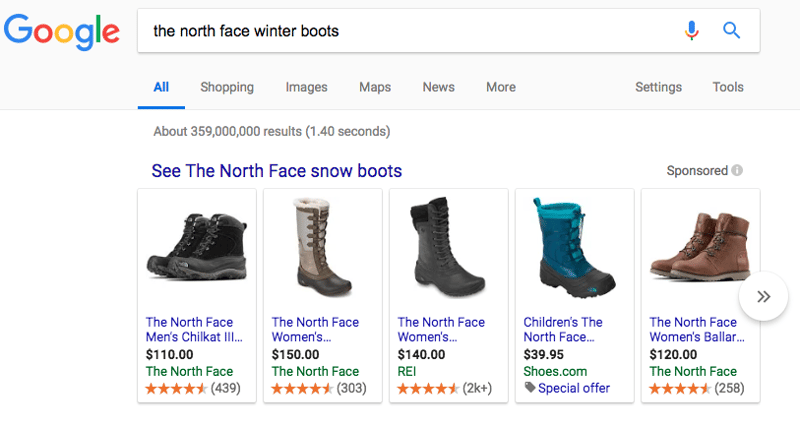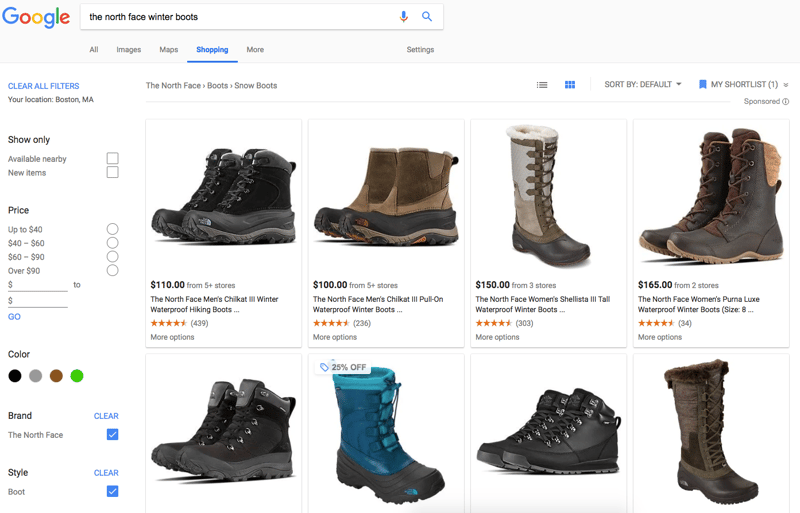
In its latest iteration, Google’s ecommerce-targeted advertising holds massive potential for ecommerce stores large and small. Google Shopping isn’t really new — if you’ve used Google to research a purchase in the last several years, you’ve probably seen these ads.
But it continues to grow exponentially each year. Between 2015 and 2016 alone, mobile searches that triggered Shopping ads grew by 117%. That’s why ecommerce brands are jumping at the chance to bid for ads that empower users with more information and a better user experience for online shopping. Not to mention, those clicks you pay for are a lot more valuable when users have that kind of information at their fingertips.
Before you dive in, let’s talk more about what Google Shopping is and how it differs from AdWords text-based ads and other pay-per-click (or PPC) options.
What is Google Shopping?
At its most basic, Google Shopping is an online advertising channel that works much like any other pay-per-click service. You bid a certain amount money to have your product ads shown, and the ad with the highest bid appears in Google searches.
Just like text-based Google ads, you create Google Shopping ads from within your Google Ads (formerly Adwords) account. For Shopping ads, you’ll create a templated ad. Then the individual product information for each ad is pulled from a feed of your products in Google Merchant Center.
With Google Shopping, your ad includes more than just a headline and meta description — Google Shopping ads (also called Product Listings Ads, or PLAs) include a lot more than that. They include an image, pricing information, your store’s name, shipping information… even star ratings out of 5.
When a user searches for a term with high buying intent (meaning they’re ready to make a purchase, today), Google Shopping ads appear in one of two ways:
- As a carousel, above text-based ads in the All results tab

- And in their own separate Shopping tab

How Are They Different From Text and Other PPC Ads?
For the most part, Google Shopping ads work similarly to regular text-based ads you may have tried before. However, over the last 2 years, over 50% of spend in AdWords has moved over from text to Shopping ads.
So there must be something that sets Google Shopping apart from text ads, right? Right.
Cost-per-click is Lower
One of the biggest differences, for sellers starting an online store in particular, is that the cost-per-click (or CPC) is almost always much lower for Google Shopping ads versus text ads. Since only ecommerce brands can use Google Shopping, the demand and competition for ad space is lower, driving down CPC.
Google Shopping Ads Contain a Lot More Info
Another key difference is all of the extra information you can include in Google Shopping ads. The users that Google Shopping sends to your store are much more targeted — because they already have information like pricing, shipping, star rating, and other available options. So they’re more likely to actually complete a purchase.
The lower cost and more targeted use of clicks make Google Shopping ads a whopping 73.2% more cost effective for small ecommerce stores.
Keywords Work a Little Differently
The last major difference is how keywords work. With traditional text ads, the advertiser (that’s you) tells Google which keywords they want their ad to be shown for. It works a little differently with Google Shopping.
When you input your product catalog into the Google Merchant Center feed, Google automatically chooses which search terms your ads will show up in. It bases that primarily on the product names and descriptions. So your control over which searches your ads appear in is less direct, but you do still have some say over your keywords.
Why Should Ecommerce Sellers Care About Google Shopping?
Now that you have a good understanding of Google Shopping and how it differs from traditional text-based Google Ads, why should you care? Simply put, because Google Shopping ads have an outsized effect on the value your store derives from PPC advertising.
From what Google Shopping enables you to do to the users it drives to your store, there are myriad benefits for both you and your customers (both current and future). Let’s take a look at some of the most impactful ones:
- You can target users with higher purchase intent. When we talk about “high purchase intent,” we’re referring to search terms that indicate a user is ready to buy now — not just looking for information or researching a future purchase. These are the searches where Google shows Shopping ads, and they’re much easier to target through Google Shopping segmentation than AdWords text ads.
- Google Shopping yields greater ROI for your ad spend. We already noted that two of the major differences between Google Shopping and text ads are the (1) cost and (2) how targeted the audience is. Those two things lead to much greater return on your advertising spend.
- Searchers engage more with Shopping ads. A recent study found that Google searchers were as much as 3 times more likely to click on a Google Shopping ad than a text-based ad.
- Google Shopping ads eliminate some of the friction of ecommerce. With traditional search, organic or paid, there’s always some friction between hitting “Search” and reaching the order confirmation page. Potential customers naturally fall off with each step. Google Shopping ads get rid of a few extra steps, making it easier for customers to convert.
- Ads are highly measurable. Pay-per-click ads in general, and Google Shopping ads in particular, are very easy to measure. All of the important metrics like impressions, click-through rate, and conversion rate are right there in your AdWords account. That makes is incredibly easy to track performance and further improve your ads.
Your competitors are already there.
Simply put, whether you’re taking advantage of Google Shopping ads or not, you can be sure your competitors are. Don’t cede that territory when you can turn it into your competitive advantage instead. Use a Google-ready shopping cart software that helps you connect your catalog directly from your online store to Google Merchant Center.





Leave a reply or comment below